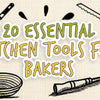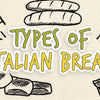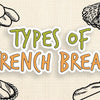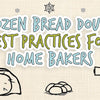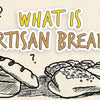What is Artisan Bread? The Home Baker's Guide
Artisan bread refers to any hand-crafted bread that has been prepared by an artisan baker. The artisan baker incorporates the science behind the fermentation of ingredients to keep the chemical reactions in optimal conditions. The process of baking it is highly specialized from mixing ingredients, shaping the loaf, fermenting, and finally baking.
Artisan bread tends to focus on unique tastes, whereby, the craftsperson may focus on preparing sourdough bread or flavored bread in which case the artisan will pick out the unique ingredients that help to bring out the required flavor. However, as a general rule artisan baker do not use chemicals, the bread is supposed to be prepared using only natural ingredients like it has been done for hundreds of years before.
Not Much Time? Skip To What You’d Like To Learn……..

Origin of Artisan Bread

It's nearly impossible to pinpoint precisely when and where artisan breads originated from. However, based on historical findings, we can conclude that the first ancient bread bakers were actually artisan bakers. For this reason, then the earliest evidence of artisan breads points to an Egyptian and Mesopotamian origin. Bread is said to have been baked in these regions more than 5000 years ago.
The modern artisan bread culture is still relatively young, and it traces its roots in modern day Europe. Where some family-owned bakeries decided to take authenticity path instead of business growth and expansion, which lead to the growth of commercial bakeries. However, with the renewed interest in healthy bread, artisan bakeries have started making a comeback.
5 Common Types

1. Sourdough
This is our ultimate sourdough recipe (link)
Try enjoying it this way (link)
Sourdough may be the ultimate artisan bread, it's demanding in terms of the preparation process and has a unique flavor that cannot be replicated in any commercial baking process. The secret to baking the perfect sourdough is using lactobacillus culture as a starter instead of yeast.
Sourdough bread has a crusty texture with a distinctive tangy taste; this is as a result of the fermentation of the sugars in the wheat by the bacteria culture. The crisp and chewy nature of this bread means that it can be eaten with just about anything. If you are feeling particularly adventurous, you can hollow out your loaf of sourdough and make it into a bread bowl for any kind of thick soup.
2. Ciabatta
Check out our favorite ciabatta recipe (link)
Want different ways to eat it? Try this (link)
Ciabatta is an Italian bread characterized by a somewhat elongated flat shape like a slipper. In fact, in Italian, ciabatta translates to ‘slipper’. But don’t let the name fool you, this bread has been likened to the Famous French baguettes thanks to its rustic flavor.
Unlike other artisan varieties, ciabatta has a high hydration content giving it a chewy center that also has tons of irregular holes. Simply slice it and dip into your favorite soup or sauce. The spongy interior will soak up all that sweetness without falling apart.
3. French Baguette
Try making a French baguette with this recipe (link)
Need some inspiration for how to enjoy it? Check out this post (link)
The French baguette is not only easy to bake thanks to the numerous guides available, but it also follows a somewhat iconic but straightforward recipe. By law, for any loaf to be referred to as ‘French,’ it must only contain wheat, water, salt, and yeast. What sets baguettes aside from other bread varieties with a similar recipe is the design aspect, they are thin and long. This allows the crust to develop a rich taste and crispy texture during baking.
Baguette can be consumed as a classic breakfast toast, with grilled cheese or better yet use it to prepare croutons. Baguettes can transform any meal or sandwich into a sophisticated gourmet meal.
4. Rye Bread
Fancy making your own rye loaf? Here is a recipe for you (link)
Check this post out for 6 ways to enjoy your rye (link)
Rye may not abide by the four ingredients recipes that other artisan bread varieties are based on, but its preparation is still an artistic art. Packed with high fiber and nutrients rye bread makes for a perfect alternative for anyone with wheat allergy, albeit rye is also closely related to wheat.
Wondering how to enjoy your rye bread? How about with the classic smoked salmon and cream cheese. This combo not only offers the perfect clash of flavors but also complements the chewy crust.
5. Bagel
Interested in making your own bagels? Check this recipe out (link)
Try eating it like this (link)
The original bagel recipe requires only flour, salt, water, and yeast, thus making it a perfect artisan bread. While it might have the shape of a donut, the preparation process includes shaping, letting the dough to rise, quick boil and finally baking. The result? A browned crispy exterior with a dense, chewy interior.
Bagels are fun to eat, but they also make for a great pairing with multiple dishes such as avocado, cheddar, egg, bacon, and even salsa.
FAQs

What is artisan flour?
Artisan flour is just a fancy word for whole grain flour. This flour is milled from high-quality whole-wheat grains giving it a high fiber content. Artisan flour may also be unbleached. This means it has not been treated with bleaching agents that speed up the flour’s aging process and giving it a softer texture.
Is artisan bread vegan?
Yes, it is based on the traditional bread making recipe which only includes wheat flour, yeast, salt, and water. However, be on the lookout for some commercially sold artisan bread which includes dairy products and eggs as fillers.

